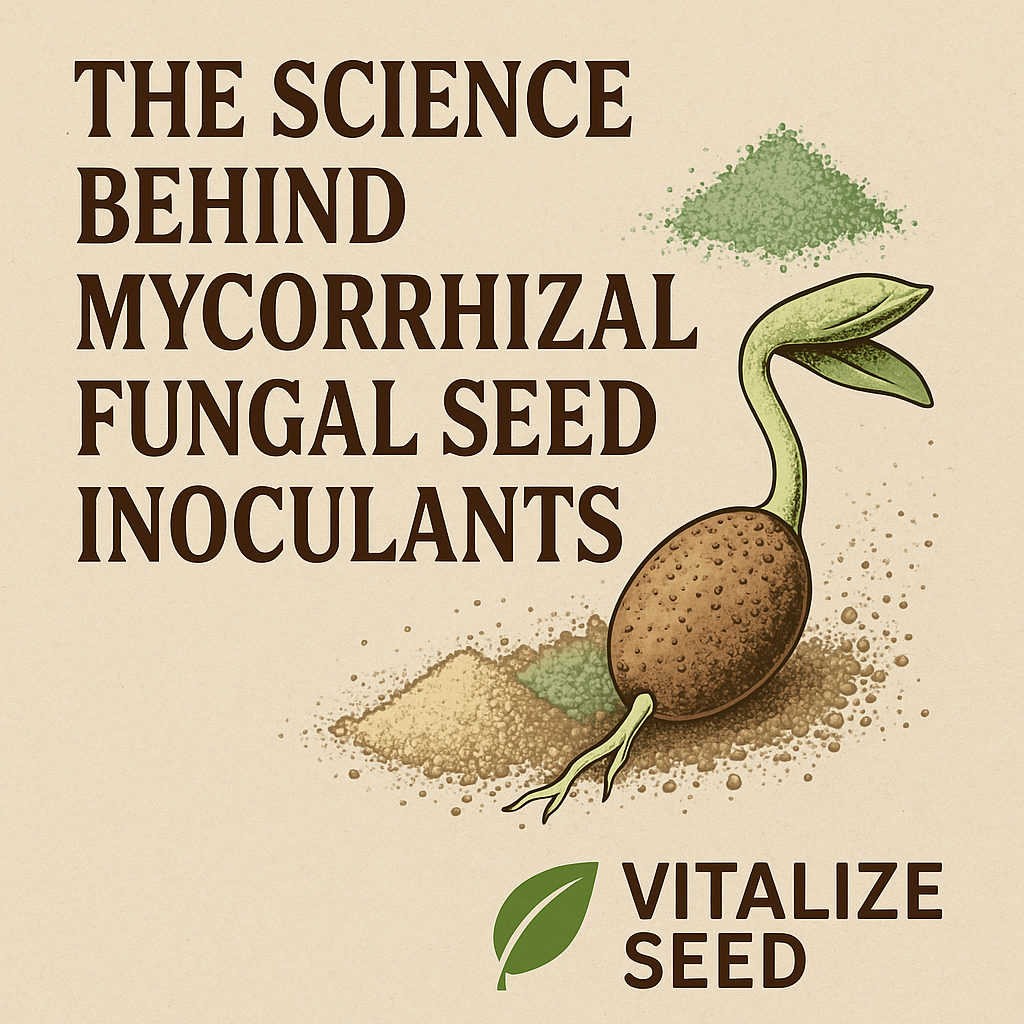
Unlocking Root Power: The Science Behind Mycorrhizal Seed Inoculants and the Vitalize Coating Stack
Share
Planting seeds is easy. Building better soil takes biology.
At Vitalize Seed, we believe in putting nature to work from the moment your seed hits the soil. Mycorrhizal fungi have been evolving with plants for hundreds of millions of years. When used as a seed inoculant, they offer a low-cost, high-impact way to improve early growth, nutrient efficiency, and long-term soil health.
Let’s take a closer look at the science behind these powerful fungi and how combining products like Spectrum+Myco, Seed Feed, and Seed Armor+ creates a synergistic seed coating strategy. This simple approach supports germination, root development, nutrient access, and plant performance—especially in no-till or low-fertility conditions.
What Are Mycorrhizal Fungi?
The term mycorrhiza comes from the Greek words for “fungus” (mykes) and “root” (rhiza). It describes a symbiotic relationship between plant roots and certain fungi, especially from the Glomeromycota group. Once colonized, these fungi form a dense network of hyphae that function like extensions of the plant's roots. In many cases, this network increases effective root surface area by more than 100 times.
In exchange for plant sugars, the fungi deliver:
- Better phosphorus uptake
- Increased access to micronutrients like zinc and copper
- Improved water absorption
- Enhanced resilience to stress, compaction, and drought
Why Use Mycorrhizal Fungi on Seed?
Soils that have been tilled, compacted, or heavily fertilized often have reduced microbial activity. In these conditions, native populations of mycorrhizal fungi are often sparse or inactive. Applying them directly to seed ensures the symbiosis starts at germination.
Benefits include:
- Faster nutrient uptake
- Enzymatic breakdown of tied-up nutrients
- Healthier, more vigorous plants
- Reduced need for synthetic fertilizers
- Long-term improvements to soil structure and carbon retention
Seed Feed: Organic Nutrition That Stays With the Seed
Seed Feed delivers low-salt, organically buffered NPK along with humic and fulvic acids. By applying it directly to seed, nutrients are available at the exact time and place roots need them most. This is particularly important in no-till systems where phosphorus and other nutrients often remain tied up in surface residue.
What the research shows:
- Humic acid treatments increase germination speed, root growth, and shoot development
- Maize and faba bean trials show increased chlorophyll, biomass, and nutrient density using humic-coated seed
- Some trials show 25 percent less fertilizer needed when humic acid and mycorrhizae are used together
“Seed priming with humic substances and AMF improved root morphology and nutrient translocation in maize under reduced fertilization.”
— Adani et al., Soil Biology & Biochemistry, 2020
“Humic acid and AMF at 75 percent NPK matched full yields and improved tissue nutrient levels.”
— Mirbakhsh et al., 2023
Seed Armor+: Rhizobia to Support Nitrogen and Root Function
Seed Armor+ adds a broad mix of rhizobial bacteria along with humics. These microbes colonize root hairs and form nodules that fix atmospheric nitrogen, providing a steady supply of N to the plant.
Rhizobia also support root branching and exudation, which creates ideal conditions for mycorrhizal colonization. The result is a more biologically active root zone and better nutrient exchange between plant and soil.
“Dual inoculation with AMF and rhizobia significantly enhances nutrient uptake and plant growth.”
— Egamberdieva et al., Frontiers in Microbiology, 2017
Spectrum+Myco: Fungi That Extend the Root System
Spectrum+Myco introduces beneficial arbuscular mycorrhizal fungi (AMF) that attach to roots and form hyphal networks. These fungi can transport phosphorus, water, and trace elements from beyond the root zone back to the plant.
When applied at planting, Spectrum+Myco supports faster colonization and early root health. Combined with Seed Feed and Seed Armor+, it creates a powerful environment for plant growth.
Glomalin: The Fungal Protein That Builds Soil
AM fungi don’t just help plants—they help rebuild the soil. As they grow, these fungi release a sticky glycoprotein called glomalin into the rhizosphere. Glomalin acts like a natural glue, binding soil particles into stable aggregates.
These aggregates:
- Improve water infiltration and retention
- Reduce erosion
- Create better pore space for roots and air
- Store carbon in the soil
“Glomalin-related soil protein, produced by arbuscular mycorrhizal fungi, plays a central role in aggregate stability and carbon sequestration.”
— Rillig et al., Soil Biology & Biochemistry, 2004
By helping fungi colonize early, Spectrum+Myco contributes to both plant health and long-term soil function.
A Simple and Synergistic Stack
| Product | Role |
|---|---|
| Seed Feed | Organic NPK + humics that stimulate root growth and microbial activity |
| Seed Armor+ | Rhizobia + humics to support nitrogen fixation and root colonization |
| Spectrum+Myco | AM fungi that extend the root zone and deliver water and nutrients |
This coating strategy helps:
- Increase germination and early vigor
- Improve phosphorus and nitrogen efficiency
- Establish better root systems in compacted or low-fertility soils
- Reduce input needs over time
- Build a healthier soil ecosystem from the seed up
Real-World Use: Just Dust and Plant
Using this stack is straightforward:
- Dust the powders directly onto your seed
- Mix thoroughly to ensure even coverage
- Plant as normal into moist, warm soil
This dry-coating approach keeps the system simple, clean, and efficient—no soaking, no binders, and no extra handling needed.
Why This Matters in No-Till
No-till systems protect soil biology, but they also create challenges. Nutrients like phosphorus remain near the surface and can stay bound to organic matter or residue. Early root systems may not access them without biological help.
- Seed Feed places nutrients at the seed
- Seed Armor+ promotes nitrogen fixation and root exudates
- Spectrum+Myco helps transport nutrients and water through fungal hyphae
- This combination builds a nutrient-rich microenvironment where the seed can thrive even in tight soils or under residue.
Don’t Take Our Word for It — Here’s the Science
This approach is grounded in research:
- Adani et al. (2020): Humic substances and AMF improved root mass and nutrient uptake in maize
- Mirbakhsh et al. (2023): Humic + AMF at 75 percent NPK matched full-rate yields with better tissue nutrient density
- Egamberdieva et al. (2017): Rhizobia and AMF together improved nodulation and chlorophyll in legumes
- Rillig et al. (2004): Glomalin production by AMF stabilized soil aggregates and stored carbon
- Canellas & Olivares (2014): Humic acids improve microbial activity and nutrient uptake during early growth
The data is clear—combining fungi, rhizobia, and organic nutrition supports stronger roots, better nutrient use, and healthier soil.
Final Thoughts
By combining Seed Feed, Seed Armor+, and Spectrum+Myco, you create a smart, biologically active coating that brings nutrients, microbes, and soil-building compounds to the seed. This simple dry-on strategy gives plants the foundation they need to thrive, even in compacted or underperforming soils.
It's science-backed, grower-tested, and designed to fit the way you already plant. Every time I fill up the drill, I am using the three coatings.
